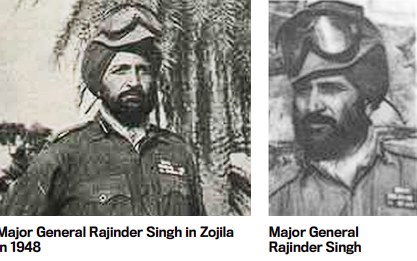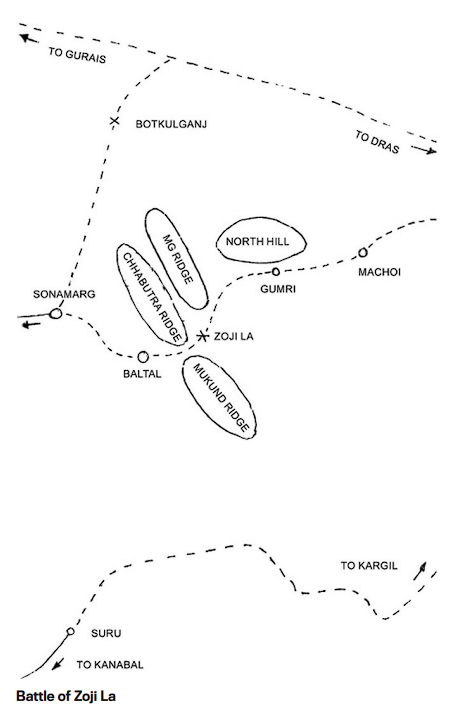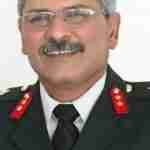Introduction
Major General Rajinder Singh was born on 03 October 1911, in Gurdaspur, Punjab. He belonged to an illustrious Punjab Jat Sikh Shergill family. He went to Khalsa College in Amritsar and then joined Army Cadet College, Now gong as a ‘Young Cadet” the 7 LIGHT CAVALRY in January 1938. He served with the Regiment during World War II.
Post Independence Major General Rajinder Singh commanded the 7th LIGHT CAVALRY from September 1947 to May 1949. He was twice awarded the Maha Vir Chakra, the second highest military decoration in India, the first for his role during the Indo-Pak War of 1947, for outstanding leadership during the advance and capture of Jhangar and the capture of Zoji La, and the second for displaying gallantry in the Indo-Pak War of 1965, in the Shakargarh Sector during which he was GOC of the First Armoured Division.

Both Father and Son Awarded For Gallantry
Major General Rajinder Singh retired from the Army on 26 September 1966. After retirement he entered politics and became a Minister in the Gurnam Singh Ministry in 1967. Later he was elected to the Lok Sabha twice in 1980 and 1984 from the Jalandhar constituency as a candidate of the Indian National Congress. He died in May 1994, at the age of 83.
Married to Mrs Sonia Rajinder Singh who passed away in January 2020, they had two sons, both of whom served in the Indian Army with distinction and honour. Lieutenant General Malvinder Singh ’Binny’ Shergill, who served in the same Regiment as his father i.e., 7 LIGHT CAVALRY and earned a Vir Chakra in the Shakargarh Sector in 1971, possibly the only case where both father and son have been awarded for gallantry in the same Sector albiet in different conflicts, and Lieutenant General Tajindar Singh ‘Maun’ Shergill from DECCAN HORSE who incidentally was taken a Prisoner of War in 1965 in the Khem Karan Sector of Punjab where he received ‘ Mentioned in Despatches’.

1947-48 War with Pakistan
The first Indo-Pak War was fought between India and Pakistan began in 1947. The bone of contention between the two countries was the attempt by Pakistan to annex the erstwhile state of Jammu and Kashmir by any means. On the map of India, the state of Jammu and Kashmir appeared as a somewhat rectangular projection in the extreme North-West corner of the sub-continent. In size it was the largest of the Indian ‘Princely States’ during the pre-independence era. It was 222,870 sq km or roughly double the area of Demark, the Netherlands, Belgium and Luxemburg combined. The state was important because of its strategic location. Even before the birth of Pakistan, Jammu and Kashmir was surrounded on almost three sides by foreign states. Today, its importance has been accentuated by recent international developments. To the East lay Tibet; to its North lies Chinese Turkestan or Sinkiang (Xinjiang); to West is Afghanistan; to South-West and South was Pakistan; and to the South and South-East lay the states of Punjab and Himachal Pradesh of India. The narrow Wakhan corridor, a narrow strip of territory in Afghanistan, extending to China and separating Tajikistan from Gilgit-Baltistan, was to the North West. Some of the significant battles that took place in Jammu and Kashmir were, the Battle of Badgam, capture and recapture of Jhangar, battle of Naushera, the advance to Tithawal, the relief in Punch and the fight of Chhamb to Tithwal.
In 1948, Pakistani invaders occupied the 11000 ft high Zoji La Pass. It was found difficult to dislodge them. Following the occupation of Gilgit on 02 November 1947, the Pakistani irregulars captured Kargil and Drass in May 1948. Leh finally fell on August 1948. Zoji La situated at a height of 11,575 feet was the gateway to the Ladakh. Pakistani forces had well entrenched themselves with artillery guns and heavy weaponry and were at a strong position. Major General K S Thimayya, DSO decided to send tanks to surprise the enemy. Two separate attacks in September 1948 by 77 (Para) Brigade supported by artillery and air support were beaten back with heavy casualties and Zojila appeared impregnable. Thedecision to employ the Stuart light tanks of 7 LIGHT CAVALRY under its CO, Lieutenant Colonel Rajinder Singh ‘Sparrow’ along with the infantry proved decisive. He achieved the unique task of taking his tanks on the Pass in spite of overwhelming odds. To ensure secrecy, he moved the tanks in a dismantled condition. All movement was at night, and during the day the tanks were covered by tarpaulin sheets.
The Squadron was concentrated in Baltal by 15 October, and it was decided to launch the operation on 20 October. Two field Companies of Madras Sappers had worked day and night to improve the mule track from Baltal to Zoji La and on to Gumri, for movement of tanks.
The operation had to be postponed to 01 November due to heavy snow. Tanks followed by infantry commenced the advance to Gumri and attack from the rear, while the infantry was to put in frontal attack. It was snowing that day too, and the Air Force could not be employed. The operation commenced as planned with heavy bombardment by the two Regiments of 25 pounder guns and one regiment of 3.7 inch mortars. Major General Thimayya rode in the leading tank. Low visibility due to snow was an advantage as there was no interference from the enemy. The column reached Gumri by 1400 hours. The appearance of tanks was a complete surprise to the enemy, and they fled in panic. The battle had taken place under severe conditions of difficult terrain and low temperature. It was the first time that tanks had been employed at such heights. The enemy was completely surprised and abandoned the Pass. This was a record of highest altitude for employment to tanks. This paved the way for 77 Para Brigade to advance and capture Kargil and effect a link-up with Leh on 23–24 November 1948. Lieutenant Colonel Rajinder Singh ‘Sparrow’ was awarded the Maha Vir Chakra.
As per some reports, it was after the battle for Zoji La during the Indo-Pak war (1947-1948) that Lieutenant Colonel Rajinder Singh got the name Sparrow. However, he was called Sparrow in school for having recited a long poem;’ I am a Little Sparrow’ by heart. During the battle for Zojila, Lieutenant Colonel Rajinder Singh was assigned the near-impossible task of moving 7 LIGHT CAVALRY Regiment comprising of Stuart tanks to the battleground at 11000 ft. Accomplishing the task in record time, the 7 Cavalry scared off the Pakistani intruders and forced them to fly off the scene.

The 1965 Indo- Pak War
The Indo-Pak War of 1965 was the second war fought between these two bordering countries. While India was still recovering from the damages of Sino-India war of 1962, Pakistan saw it as an opportunity to acquire Jammu and Kashmir with might, presuming India to be weak in terms of defence preparation. The war initiated on 24 April 1965, when Pakistan Army, attacked our territory in the Rann of Kutch and penetrated six to eight miles inside the Indian territory. This act of illegal occupation of Indian Territory constituted violation of Indo-Pak Border Agreement 1960 and international law as per the United Nations Charter. The Pakistani forces subsequently intruded in Kashmir with the launch of Operation Gibraltar.
The war of 1965 was fought in various Sectors among which, the Armoured Division commanded by Major General Rajinder Singh ‘Sparrow’ was assigned the task of capturing the Phillora and Pagowal in the Sialkot Sector. 1 Corps was responsible to carry out offensives at Sialkot-Shakargarh Sector. 1 Corps was tasked to secure area Pagowal, Phillora, Chawinda and the Tharoh crossroads with a view to securing Marala-Ravi Link Canal (MRLC). POONA HORSE whose CO Lieutenant Colonel Adi Tarapore was awarded the PVC was part of 1 Armoured Division which was commanded by Major General Rajinder Singh Sparrow, MVC.
With two Armoured Regiments with Patton tanks of the enemy in the area, the attack on 11 September resulted in the biggest tank battle since the Second World War. Sixty-nine Pakistani tanks were destroyed against nine of India. After an intense fight the battle at Phillora was won.
Major General Sparrow led his formation to win against a better equipped and a numerically superior enemy and Phillora was cleared by 16 September. As a result of his brilliant handling of the Division, the pride of Pakistan Army; their 6 Armoured Division was defeated. Major General Rajinder Singh was awarded the Maha Vir Chakra for the second time for his bravery, leadership and skilful handling of his forces.

Conclusion
Major General Rajinder Singh was a keen hockey and Polo player too. He was a +4 handicapped Polo player and his wife, Sonia Rajinder Singh presented the General Sparrow Polo Cup to the then Army Chief, General VK Singh, PVSM, AVSM, YSM, ADC in 2011 in memory of her late Husband.
The legacy of General Sparrow continues to inspire future generations. His leadership and courage during War and his planning and conduct of mechanised operations in varied terrains from high altitude to the developed obstacle ridden
terrain of Punjab is part of the annals of military history. Credited as the man with the most spectacular success against Pakistan he is one of the six to have been awarded the Mahavir Chakra twice he was brave, committed and an inspiring leader who focussed on getting the job done had the ability to deliver under the most adverse conditions.


